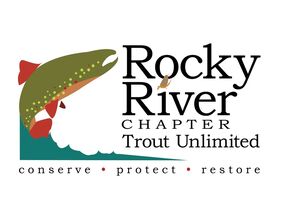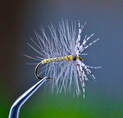Fly of the Month
Our research, study and publication of fly patterns over the last five years covers great fly patterns that catch fish, originating by creative authors, industrious fly shop owners and staff, experienced guides or problem-solving anglers who are each tyers that innovate and develop a fly pattern locally. Then, the secret fly or the promoted fly at some point goes viral. Such flies may have been developed in the Catskills, anywhere in the Southern Appalachians, in the mid-west, in the Ozarks, out west, on the west coast, in Alaska, in Canada, in Patagonia, in Europe, In South Africa, in Australia, in New Zealand or anywhere there are fly fishing opportunities. The story and the origin of the fly pattern gives us a hint as to why such a fly pattern exists and possibly a background as to why it has been successfully utilized.
Thus, the Fly of the Month is more than a recipe presented. In this article, we present a fly of French origin that dates to 1964. Jean Paul Pequegnot first published his book of French Fishing Flies in 1984, 1987 and most recently the third edition in 2012. In researching ancient flies, we discovered that fly patterns based on a palmered body is a “tying technique of spiraling a hackle laterally along the shank or body of a fly; the hackled, artificial fly resembling the Palmer worm, a hairy, wandering tineid moth larva, dated 1651.” HYPERLINK "http://www.thelimpcobra.com" www.thelimpcobra.com. The dictionary definition of a Palmerworm is a caterpillar that suddenly appears in great numbers devouring herbage. The French fly we present is a palmered fly from page 22-23 of Jean Paul’s book.
(French) Assassine
Jean Paul’s approach is to combine the advantages of palmering with the attractive properties of speckled partridge hackle. At first this sounds like a soft hackle fly pattern, but his unique approach provides an excellent, high-floating dry fly pattern with the inherent attraction of a caterpillar. The high-floating capabilities come from the palmering of stiff hackle that provides both the floatation and the support to the soft hackle via three wraps adjoining.
In France, this fly is tied in size 10 and used during the Green Drake hatch. Although it is not intended to imitate any specific insect, the sizing should match the seasonal bugs. It is a no brainer to select this fly if you observe caterpillars on the banks and overhanging vegetation.
This is a simple, effective and easy fly pattern to tie in good numbers at a fly tying session.
Flies of the Month 10.17
(French) Assassine
……photo, recipe and instructions for each…….
- Tom Adams, Alen Baker
Fly of the Month
Our research, study and publication of fly patterns over the last five years covers great fly patterns that catch fish, originating by creative authors, industrious fly shop owners and staff, experienced guides or problem-solving anglers who are each tyers that innovate and develop a fly pattern locally. Then, the secret fly or the promoted fly at some point goes viral. Such flies may have been developed in the Catskills, anywhere in the Southern Appalachians, in the mid-west, in the Ozarks, out west, on the west coast, in Alaska, in Canada, in Patagonia, in Europe, In South Africa, in Australia, in New Zealand or anywhere there are fly fishing opportunities. The story and the origin of the fly pattern gives us a hint as to why such a fly pattern exists and possibly a background as to why it has been successfully utilized.
Thus, the Fly of the Month is more than a recipe presented. In this article, we present a fly of French origin that dates to 1964. Jean Paul Pequegnot first published his book of French Fishing Flies in 1984, 1987 and most recently the third edition in 2012. In researching ancient flies, we discovered that fly patterns based on a palmered body is a “tying technique of spiraling a hackle laterally along the shank or body of a fly; the hackled, artificial fly resembling the Palmer worm, a hairy, wandering tineid moth larva, dated 1651.” HYPERLINK "http://www.thelimpcobra.com" www.thelimpcobra.com. The dictionary definition of a Palmerworm is a caterpillar that suddenly appears in great numbers devouring herbage. The French fly we present is a palmered fly from page 22-23 of Jean Paul’s book.
(French) Assassine
Jean Paul’s approach is to combine the advantages of palmering with the attractive properties of speckled partridge hackle. At first this sounds like a soft hackle fly pattern, but his unique approach provides an excellent, high-floating dry fly pattern with the inherent attraction of a caterpillar. The high-floating capabilities come from the palmering of stiff hackle that provides both the floatation and the support to the soft hackle via three wraps adjoining.
In France, this fly is tied in size 10 and used during the Green Drake hatch. Although it is not intended to imitate any specific insect, the sizing should match the seasonal bugs. It is a no brainer to select this fly if you observe caterpillars on the banks and overhanging vegetation.
This is a simple, effective and easy fly pattern to tie in good numbers at a fly tying session.
Flies of the Month 10.17
(French) Assassine
……photo, recipe and instructions for each…….
- Tom Adams, Alen Baker
Our research, study and publication of fly patterns over the last five years covers great fly patterns that catch fish, originating by creative authors, industrious fly shop owners and staff, experienced guides or problem-solving anglers who are each tyers that innovate and develop a fly pattern locally. Then, the secret fly or the promoted fly at some point goes viral. Such flies may have been developed in the Catskills, anywhere in the Southern Appalachians, in the mid-west, in the Ozarks, out west, on the west coast, in Alaska, in Canada, in Patagonia, in Europe, In South Africa, in Australia, in New Zealand or anywhere there are fly fishing opportunities. The story and the origin of the fly pattern gives us a hint as to why such a fly pattern exists and possibly a background as to why it has been successfully utilized.
Thus, the Fly of the Month is more than a recipe presented. In this article, we present a fly of French origin that dates to 1964. Jean Paul Pequegnot first published his book of French Fishing Flies in 1984, 1987 and most recently the third edition in 2012. In researching ancient flies, we discovered that fly patterns based on a palmered body is a “tying technique of spiraling a hackle laterally along the shank or body of a fly; the hackled, artificial fly resembling the Palmer worm, a hairy, wandering tineid moth larva, dated 1651.” HYPERLINK "http://www.thelimpcobra.com" www.thelimpcobra.com. The dictionary definition of a Palmerworm is a caterpillar that suddenly appears in great numbers devouring herbage. The French fly we present is a palmered fly from page 22-23 of Jean Paul’s book.
(French) Assassine
Jean Paul’s approach is to combine the advantages of palmering with the attractive properties of speckled partridge hackle. At first this sounds like a soft hackle fly pattern, but his unique approach provides an excellent, high-floating dry fly pattern with the inherent attraction of a caterpillar. The high-floating capabilities come from the palmering of stiff hackle that provides both the floatation and the support to the soft hackle via three wraps adjoining.
In France, this fly is tied in size 10 and used during the Green Drake hatch. Although it is not intended to imitate any specific insect, the sizing should match the seasonal bugs. It is a no brainer to select this fly if you observe caterpillars on the banks and overhanging vegetation.
This is a simple, effective and easy fly pattern to tie in good numbers at a fly tying session.
Flies of the Month 10.17
(French) Assassine
……photo, recipe and instructions for each…….
- Tom Adams, Alen Baker

